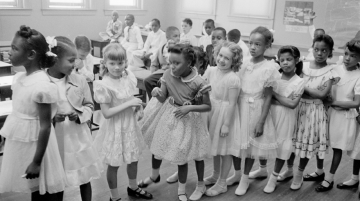
Of all the civil rights for which the world has struggled and fought for 5,000 years, the right to learn is undoubtedly the most fundamental. ... The freedom to learn ... has been bought by bitter sacrifice. And whatever we may think of the curtailment of other civil rights, we should fight to the last ditch to keep open the right to learn.W.E.B. DuBois, The Freedom to Learn ([1949], 1970, p. 230)
In 1968, the Kerner Commission Report concluded that the nation was “moving toward two societies, one black, one white—separate and unequal.” Without major social changes, the Commission warned, the U.S. faced a “system of apartheid” in its major cities. Today, 50 years after the report was issued, that prediction characterizes most of our large urban areas, where intensifying segregation and concentrated poverty have collided with disparities in school funding to reinforce educational inequality.
While racial achievement gaps in education have remained stubbornly large, segregation has been increasing steadily, creating a growing number of apartheid schools that serve almost exclusively students of color from low-income families. These schools are often severely under-resourced, and they struggle to close academic gaps while underwriting the additional costs of addressing the effects of poverty—hunger, homelessness, and other traumas experienced by children and families in low-income communities.Darling-Hammond, L. (2010). The Flat World and Education: How America’s Commitment to Equity Will Determine Our Future. New York, NY: Teachers College Press. For all these reasons, research has found that the extent to which students attend schools with other students from low-income families is one of the strongest predictors of their achievement.Reardon, S. F., Robinson, J. P., & Weathers, E. S. “Patterns and Trends in Racial/Ethnic and Socioeconomic Academic Achievement Gaps.” In H. A. Ladd & E. B. Fiske (Eds.), Handbook of Research in Education Finance and Policy (Second ed.). Mahwah, NJ: Lawrence Erlbaum.
These trends once again threaten the very fabric of our nation, as gaps in educational opportunity and attainment continue at a time when those without education are locked out of the knowledge-based economy we face.
Growing Segregation and Poverty
The root of inequality in educational outcomes in the United States is the combination of growing poverty and resegregation, along with inequality in school funding and resources. U.S. childhood poverty rates have grown by more than 50% since the 1970s and are now by far the highest among OECD nations, reaching 22% in the last published statistics.U.S. Department of Health and Human Services, Office of the Assistant Secretary for Planning and Evaluation. (2012). Information on poverty and income statistics: A summary of 2012 current population survey data, AASS 2012 issue brief. Washington, DC: Department of Health and Human Services. More than half of children attending U.S. public schools now qualify for free or reduced-price lunch—the highest percentage since the National Center for Education Statistics began tracking this figure decades ago.Southern Education Foundation. (2015). A new majority: Low-income students now a majority in the nation’s public schools. Atlanta, GA: Author. Furthermore, American children living in poverty have a much weaker safety net than their peers in other industrialized countries, where universal health care; housing subsidies; and high-quality, universally available child care are the norm.
In addition, a growing share of children from low-income families attend school in districts where poverty is concentrated, creating huge educational challenges. In 2012, nearly half (46%) of low-income students lived in high-poverty districtsBaker, B., Sciarra, D. G., & Farrie, D. (2015). Is school funding fair? A national report card. Newark, NJ: Education Law Center. (see Figure 1). The growing poverty caused by the Great Recession of 2007–09 contributed to this concentration, and the growing U.S. disparity in incomes and wealth—now wider than it has been since 1929—has reinforced it.
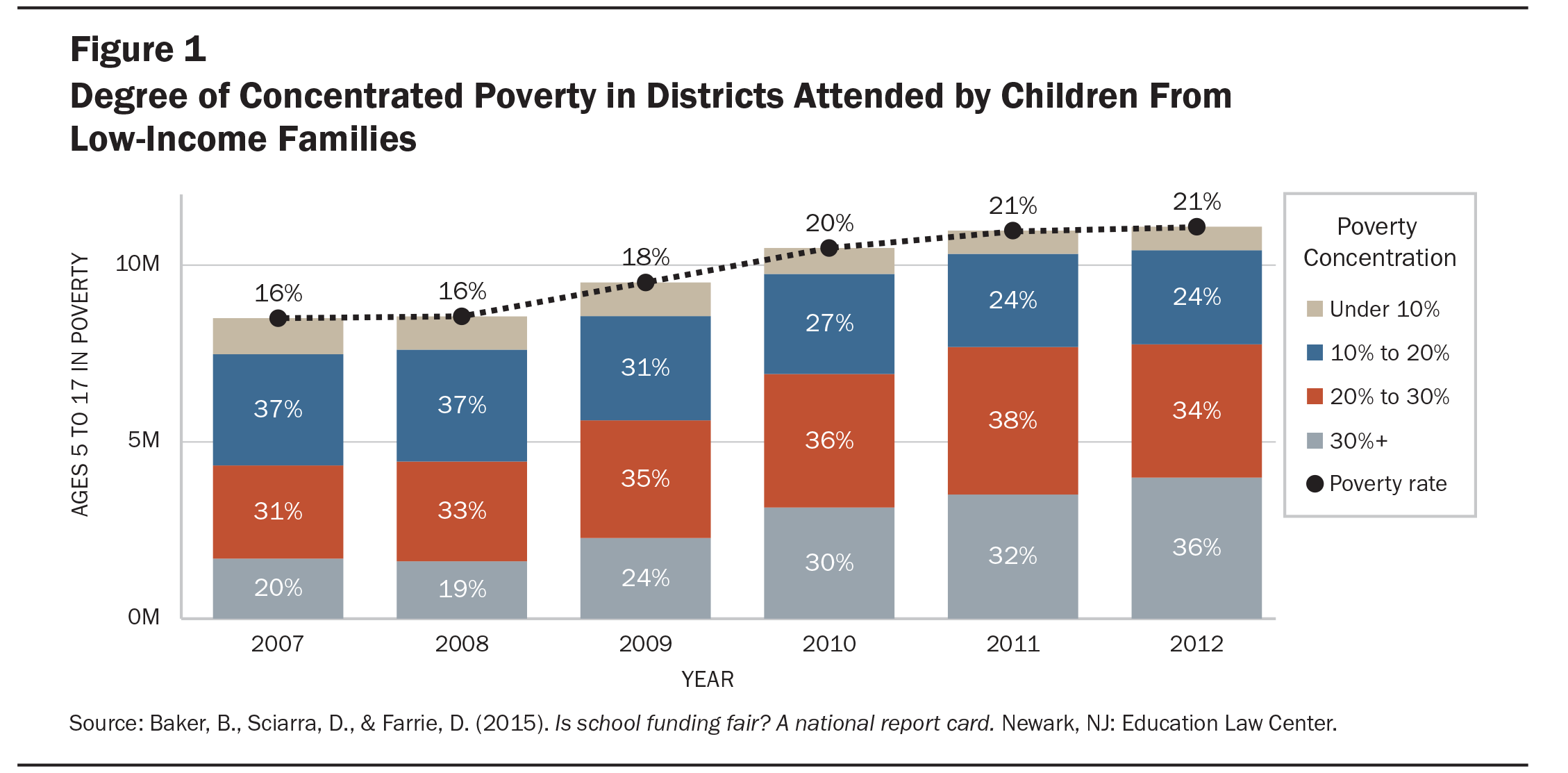
In most major American cities, a majority of African American and Latino students attend public schools where at least 75% of students are from low-income families.Boschma, J., & Brownstein, R. (2016, February 29). The concentration of poverty in American schools. The Atlantic; National Equity Atlas. (n.d.). Indicators: School poverty. (accessed 07/08/17). Increasingly, these schools are segregated by both race and class. For example, in Chicago and New York City, more than 95% of both Black and Latino students attend majority-poverty schools, most of which are also majority-minority.Boschma, J., & Brownstein, R. (2016, February 29). The concentration of poverty in American schools. The Atlantic. As the UCLA Civil Rights Project data show, high-poverty schools are almost entirely populated by Black and Latino students, and low-poverty schools have very few such students (see Figure 2).

After a dramatic decline in segregation in the two decades after 1968, especially in the South, resegregation was sparked by the discontinuation of desegregation assistance and court orders in many districts, coupled with increasing residential segregation that was exacerbated by the loss of affordable housing subsidies. By 2010, about 40% of Black students nationwide—and more than 50% in the Northeast—attended intensely segregated schools (where students of color constitute 90% or more of the total).
Today, about half as many Black students attend majority White schools (just over 20%) as did so in 1988, when about 44% did so (see Figure 3). Research has shown that, together, high rates of poverty, housing segregation, and economic polarization “have left most African American and Hispanic students marooned in schools where economic struggle is the rule and financial stability—and all the social and educational benefits that flow from that—is very much the exception.”Boschma, J., & Brownstein, R. (2016, February 29). The concentration of poverty in American schools. The Atlantic.
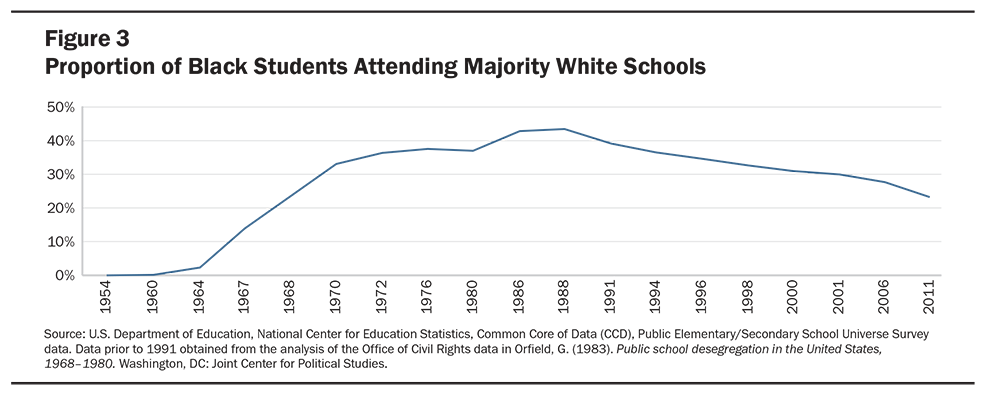
One reason for this growing resegregation is the abandonment of desegregation orders in many cities. The degree of segregation declined significantly in districts under court oversight, but climbed rapidly to even higher levels when court oversight was terminated (see Figure 4).
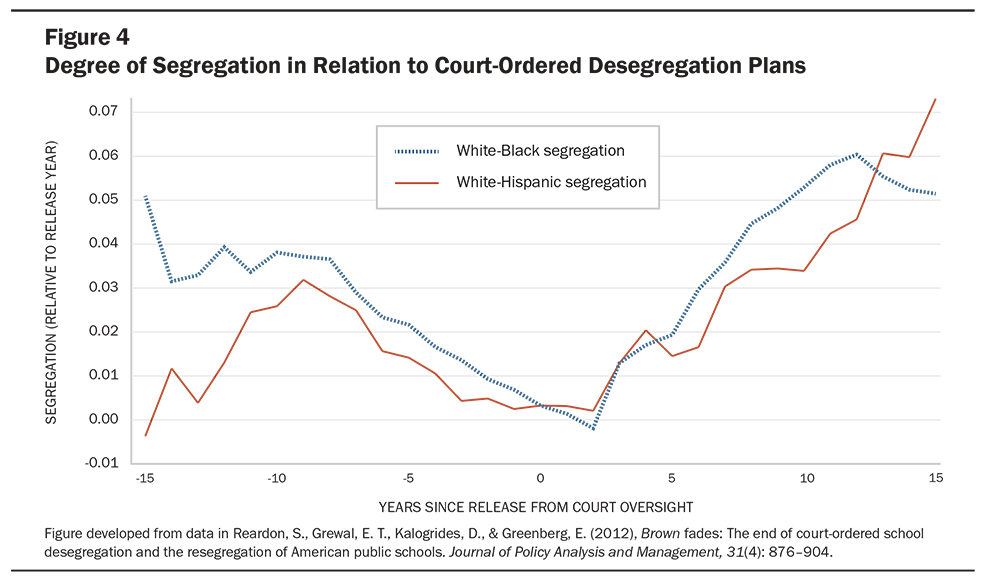
Educational Achievement Gaps Continue
Where children go to school matters greatly for their success. In a case challenging school desegregation efforts in Jefferson County, KY, and Seattle, WA, more than 550 scholars signed onto a social science report filed as an amicus brief, which summarized extensive research showing the persisting inequalities of segregated minority schools. The scholars concluded that:
(M)ore often than not, segregated minority schools offer profoundly unequal educational opportunities. This inequality is manifested in many ways, including fewer qualified, experienced teachers, greater instability caused by rapid turnover of faculty, fewer educational resources, and limited exposure to peers who can positively influence academic learning. No doubt as a result of these disparities, measures of educational outcomes, such as scores on standardized achievement tests and high school graduation rates, are lower in schools with high percentages of nonwhite students.American Educational Research Association (2006). Brief amicus curiae filed in Parents Involved in Community Schools v. Seattle School District No. 1. 127 S. Ct. 2738.
In a study of the effects of court-ordered desegregation on students born between 1945 and 1970, economist Rucker Johnson found that graduation rates climbed by 2 percentage points for every year a Black student attended an integrated school.Johnson, R. C. (2011). Long-run impacts of school desegregation and school quality on adult attainments. (NBER working paper #16664). Cambridge, MA: National Bureau of Economic Research. A Black student exposed to court-ordered desegregation for 5 years experienced a 15% increase in wages and an 11 percentage point decline in annual poverty rates. The difference was tied to the fact that schools under court supervision benefit from higher per-pupil spending and smaller student-teacher ratios, among other resources. While there were positive outcomes for Blacks, court-ordered desegregation caused no significant harm for Whites.
During the 1960s and ‘70s, many communities took on efforts like these. As a result, there was a noticeable reduction in educational inequality in the decade after the original Kerner report, when desegregation and school finance reform efforts were launched, and when the Great Society’s War on Poverty increased investments in urban and poor rural schools. At that time, substantial gains were made in equalizing both educational inputs and outcomes. The Elementary and Secondary Education Act of 1965 targeted resources to communities with the most need, recognizing that where a child grows up should not determine where he or she ends up. Employment and welfare supports reduced childhood poverty to levels about 60% of what they are todayU.S. Bureau of the Census. (2014). Current population reports, Series P-20; Current Population Survey. Washington, DC: U.S. Department of Commerce. and greatly improved children’s access to health care.
Congress enacted the Emergency School Aid Act, which supported desegregation, the development of magnet schools, and other strategies to improve urban and poor rural schools. These efforts to level the playing field for children were supported by intensive investments in bringing and keeping talented individuals in teaching, improving teacher education, and investing in research and development.
These investments paid off in measurable ways. By the mid-1970s, urban schools spent as much as suburban schools and paid their teachers as well, perennial teacher shortages had nearly ended, and gaps in educational attainment had closed substantially. Federally funded curriculum investments transformed teaching in many schools. Innovative schools flourished in many cities. Financial aid for higher education was sharply increased, especially for need-based scholarships and loans. For a brief period in the mid-1970s, Black and Latino students attended college at the same rate as Whites—the only time this occurred before or since.
Improvements in educational achievement for students of color followed. In reading, large gains in Black students’ performance in the 1970s and early ’80s reduced the achievement gap considerably, cutting it by more than half for 13-year-olds (from 39 points to 18 points on the National Assessment of Educational Progress) between 1971 and 1988 (see Figure 5).
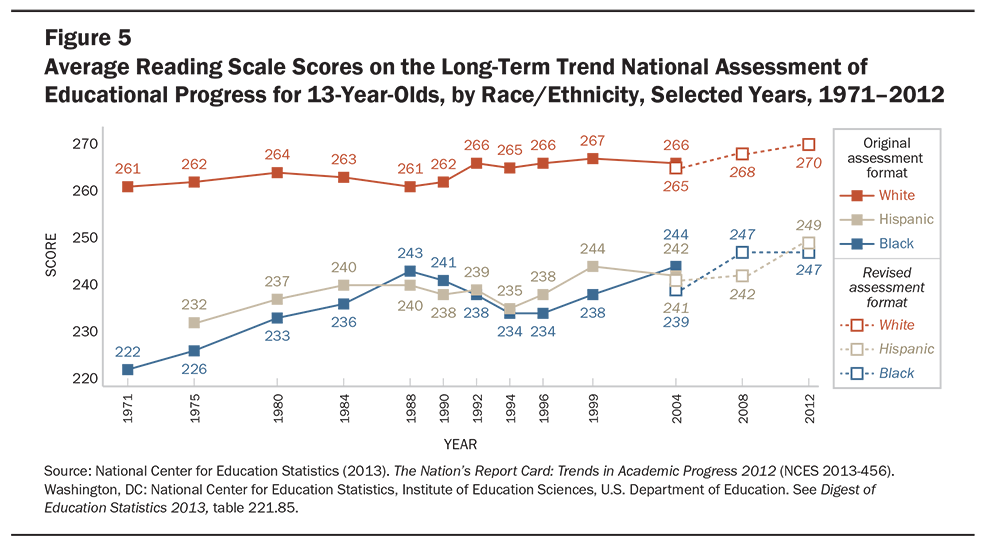
The achievement gap in mathematics also narrowed by 20 points (about one third) over the same general period of time (see Figure 6).
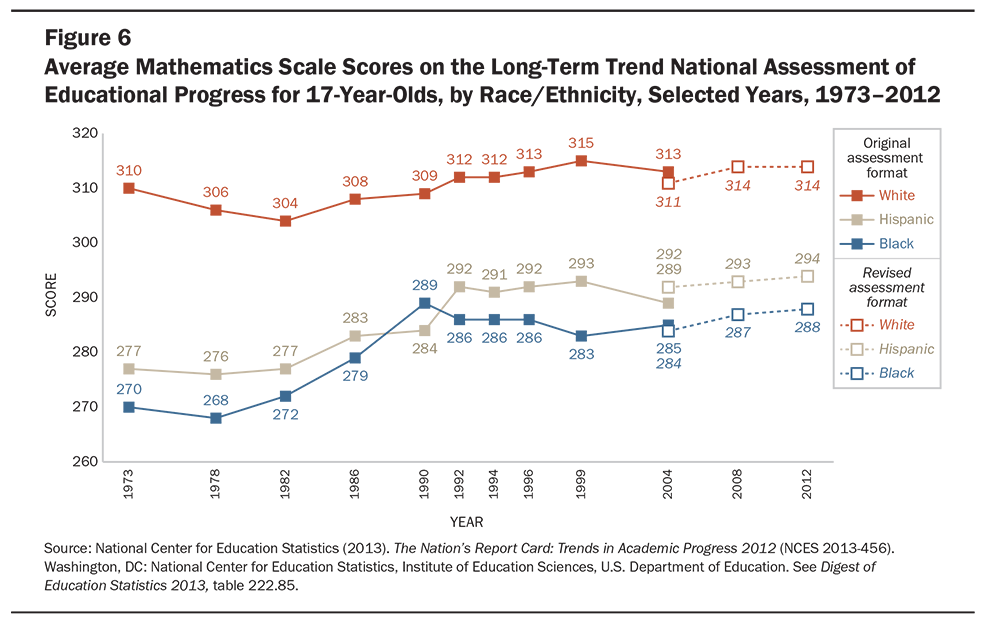
However, the gains from the Great Society programs were pushed back during the Reagan administration, when most targeted federal programs supporting investments in college access and k–12 schools in urban and poor rural areas were reduced or eliminated, and federal aid to schools was cut from 12% to 6% of a shrinking total. Meanwhile, childhood poverty rates, homelessness, and lack of access to health care grew with cuts in other federal programs supporting housing subsidies, health care, and child welfare.
By 1991, stark differences had reemerged between segregated urban schools and their suburban counterparts, which generally spent twice as much on education. Achievement gaps began to grow once again, and while there have been small gains in the 30 years since, the gaps in achievement between Black and White students are larger today than they were then (see Figures 5 and 6). For example, Black 13-year-olds have gained only 4 points in reading since 1988, while White students have gained 9 points, leaving a gap that is nearly 30% larger today than it was 30 years ago. In mathematics, Black 13-year-olds actually score a point lower than they did when the gap was smallest in 1990, while White same-age students now score 5 points higher, increasing the gap in that subject by 30% as well.
While high school completion rates have steadily risen for all groups, significant gaps in high school graduation remain for non-Asian students of color and White students (see Figure 7). While 9 out of 10 White and Asian students graduate within 4 years, 1 in 4 Black, Hispanic, and American Indian students fails to do so.
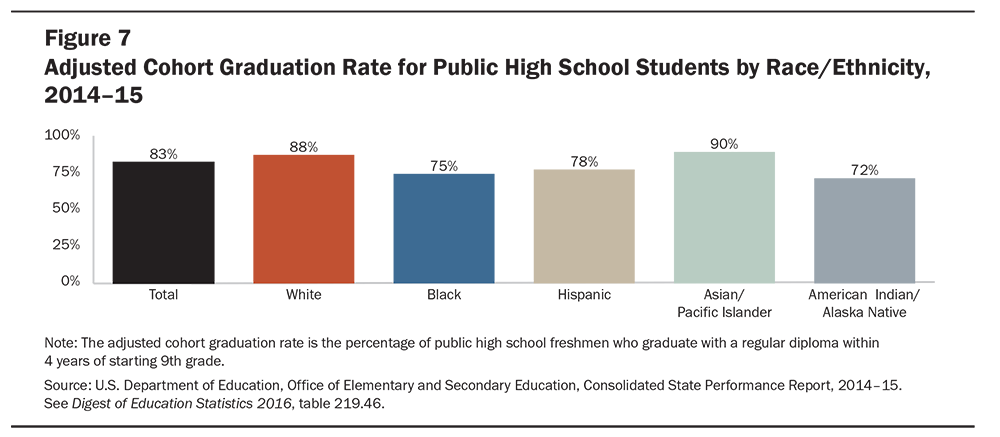
Educational shortcomings, plus lack of family resources and cuts in federal funding for financial aid, extend these disparities into higher education. At a time when more than 70% of jobs require postsecondary education, only about a third of Black and Hispanic young people ages 18 to 24 are enrolled in 2- or 4-year college, as compared to 42% of White youth (see Figure 8). In the population as a whole, disparities in access to college are obvious: Among Whites, about 33% have at least 4 years of college (and 54% of Asians do), whereas the proportions of Blacks and Hispanics are just 22.5% and 15.5%, respectively. And while there are gains to be applauded, the gaps in college attainment have grown between Whites, Blacks, and Hispanics since 1968 (see Figure 9).
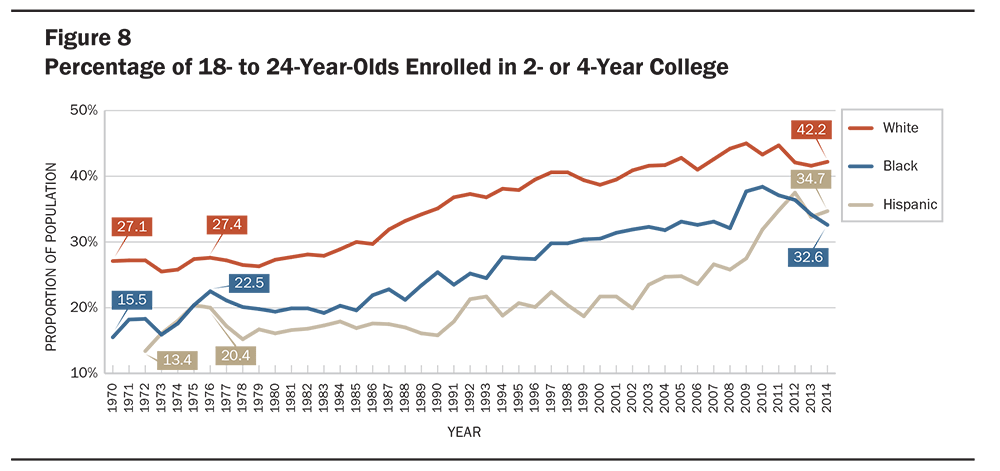
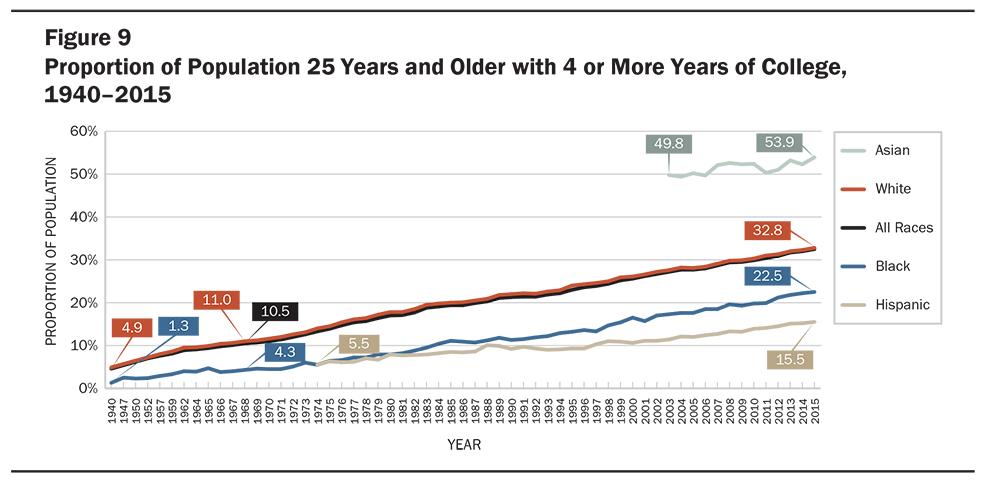
The Opportunity Gap
Despite a single-minded focus on raising achievement and closing gaps during the No Child Left Behind era (from 2002 until 2015), many states focused on testing without investing in the resources needed to achieve higher standards. Investments in the education of students of color that characterized the school desegregation and finance reforms of the 1960s and ’70s have never been fully reestablished in the years since. Ironically, had the rate of progress achieved in the 1970s and early 1980s been continued, the achievement gap would have been fully closed by the beginning of the 21st century. That did not occur.
Whereas nations like Canada, Finland, and Singapore—that are now high-achieving and equitable—built on the progressive reforms they launched in the 1970s,Darling-Hammond, L., Burns, D., Campbell, C., Goodwin, A. L., Hammerness, K., Low, E. L., McIntyre, A., Sato, M., & Zeichner, K. (2017). Empowered Educators: How Leading Nations Design Systems for Teaching Quality. San Francisco, CA: Jossey-Bass. the U.S. undid much of the progress it had made during the 1970s throughout much of the next three decades. Although some federal support to high-need schools and districts was restored during the 1990s, it was not enough to fully recoup the earlier losses, and after 2000, inequality grew once again.
These inequities are in part a function of how public education is funded in the United States. In most cases, education costs are supported primarily by local property taxes, along with state grants-in-aid that are somewhat equalizing but are typically not sufficient to close the gaps caused by differences in local property values. In most states, the wealthiest districts spend at least two to three times what the poorest districts can spend per pupil, differentials that translate into dramatically different salaries for educators, as well as different learning conditions for students.Adamson, F., & Darling-Hammond, L. (2012). Funding Disparities and the Inequitable Distribution of Teachers: Evaluating Sources and Solutions. Education Policy Analysis Archives, 20(37). Within large districts, there are also disparities in how funds are allocated to schools serving different kinds of students, usually favoring those from families with more political clout.
Furthermore, the wealthiest states spend about three times what the poorer states spend.Baker, B., Sciarra, D. G., & Farrie, D. (2015). Is school funding fair? A national report card. Newark, NJ: Education Law Center. So the opportunities available to children in the wealthiest communities of high-spending and high-achieving states such as Connecticut, Massachusetts, and New Jersey are dramatically different than the opportunities available to those in the poorest communities of low-spending states such as Arizona, Mississippi, and North Carolina, where buildings are crumbling, classes are overcrowded, instructional materials are inadequate, and staff are often transient and underprepared.
In many states where school funding litigation has been brought, plaintiffs have documented the fact that teachers in high-need schools have, on average, lower levels of experience and education, are less likely to be credentialed for the field they teach, and have lower scores on certification tests as well as other measures of academic achievement. Furthermore, a growing body of research has shown that these kinds of qualifications matter for student achievement. Studies at the state, district, school, and individual student level have found that teachers’ academic background, preparation for teaching, certification status, and experience significantly affect their students’ learning gains.For a summary, see Darling-Hammond, L. (2010). The Flat World and Education: How America’s Commitment to Equity Will Determine Our Future. New York, NY: Teachers College Press.
In combination, teachers’ qualifications can have substantial effects. For example, a large-scale study of high school student achievement in North Carolina found that students’ achievement growth was significantly higher if they were taught by a teacher who was certified in his or her teaching field, fully prepared upon entry (rather than entering through the state’s alternative “lateral entry” route), had higher scores on the teacher licensing test, graduated from a competitive college, had taught for more than 2 years, or was National Board Certified.Clotfelter, C. T., Ladd, H. F., & Vigdor, J. L. (2007). How and why do teacher credentials matter for student achievement? (NBER Working Paper 12828). Cambridge, MA: National Bureau of Economic Research. Taken individually, each of these qualifications was associated with greater teacher effectiveness. Moreover, the researchers found that the combined influence on achievement growth of having a teacher with most of these qualifications—as compared to a teacher with few of them—was larger than the effects of race and parent education combined, or the average difference in achievement between a typical White student with college-educated parents and a typical Black student with high school-educated parents. While achievement from one year to the next is still largely dependent on prior achievement, this finding suggests that the achievement gap might be reduced over time if students of color were more routinely assigned highly qualified teachers, rather than the poorly qualified teachers they most often encounter.
These findings appear to extend around the world. A 2007 study found, for example, that the most significant predictors of mathematics achievement across 46 nations included teacher’s certification, a college major in mathematics or mathematics education, and at least 3 years of teaching experience. This study also found that, although the national level of teacher quality in the United States is similar to the international average, the opportunity gap in students’ access to qualified teachers between students of high and low socioeconomic status is among the largest in the world.Akiba, M., LeTendre, G. & Scriber, J. (2007). Teacher quality, opportunity gap, and national achievement in 46 countries. Educational Researcher, 36, 369–387.
These disparities, which have come to appear inevitable in the United States, are not the norm in developed nations around the world, which typically fund their education systems centrally and equally, with additional resources often going to the schools where students’ needs are greater. These more equitable investments made by high-achieving nations are also steadier and more focused on critical elements of the system: the quality of teachers and teaching, the development of curriculum and assessments that encourage ambitious learning by both students and teachers, and the design of schools as learning organizations that support continuous reflection and improvement. With the exception of a few states with enlightened long-term leadership,Darling-Hammond, L. (2010). The Flat World and Education: How America’s Commitment to Equity Will Determine Our Future. New York, NY: Teachers College Press. the United States has failed to maintain focused investments on these essential elements.
Policies Needed to Achieve Equal Educational Opportunity
To survive and prosper, our society must finally renounce its obstinate commitment to educational inequality and embrace full and ambitious opportunities to learn for all our children. Although education is a state responsibility, federal policy is also needed to ensure that every child has access to adequate school resources, facilities, and quality teachers.
Federal Strategies
Federal education funding to states should be tied to each state’s movement toward equitable access to education resources and continued progress toward school integration. There are a number of components under the recently passed Every Student Succeeds Act (ESSA) that would support this progress, but they need to be enforced. Furthermore, the obvious truth—that schools alone are not responsible for student achievement—should propel attention to the provision of adequate health care and nutrition, safe and secure housing, and healthy communities for children. In addition to investing in universal health care and high-quality preschool for all children from low-income households, the federal government could:
- Equalize allocations of ESSA resources across states so that high-poverty states receive a greater share. Allocation formulas should use indicators of student need, with adjustments for cost-of-living differentials, rather than relying on measures of spending that disadvantage poor states.
- Enforce integrative student assignment policies and comparability provisions for ensuring that equally qualified teachers are placed in schools serving different populations of students. The law requires that districts minimize segregation in assigning students to schools and that states develop policies to balance the qualifications of teachers across schools serving more and less advantaged students, but this aspect of the law has been weakly enforced, and wide disparities continue.
- Encourage states to report on opportunity indicators to accompany their reports of school academic progress, reflecting the dollars spent; availability of well-qualified teachers; strong curriculum opportunities; books, materials, and equipment (such as science labs and computers); and adequate facilities. Evaluate progress on opportunity measures in state plans and evaluations under the law, and require states to meet a set of opportunity-to-learn standards for schools identified as failing.
State-Level Strategies to Equalize Opportunity
In the past, a common state-level strategy has been to offer state aid to offset some of the core inequality resulting from locally funded education tied to the wealth of communities and add a variety of categorical programs that give additional money for specific purposes to local districts, often with extensive strings attached and not usable for students’ most pressing needs. To address these problems, states can:
- Establish weighted student funding formulas that allocate equal dollars to students adjusted or weighted for specific student needs, such as poverty, limited English proficiency, foster care status, or special education status, as California and Massachusetts have done.
- Focus funds on the investments that matter most, such as high-quality, equitably distributed teachers and curriculum opportunities.
State efforts to rationalize resource allocations can leverage productive investments. As the Public Policy Institute of California observed:
Equalization policies should do more than alter growth in overall budget levels. We believe they should target the area of greatest inequality: teacher preparation. … Traditional redistributive policies aimed at reducing variations in revenues per pupil across districts are unlikely to equalize student achievement across all schools. … [Resource]inequality is restricted primarily to teacher training and curriculum, so that redistribution must focus on these specific characteristics of schools rather than on revenues per pupil alone.Betts, J. R., Rueben, K. S., & Danenberg, A. (2000). Equal resources, equal outcomes? The distribution of school resources and student achievement in California. San Francisco, CA: Public Policy Institute of California.
This analysis and other studies on the importance of well-prepared, committed, and culturally responsive teachers underscore the importance of a strategy like Connecticut’s that ended shortages and boosted student achievement by more equally distributing better-qualified teachers, raising and equalizing salaries, improving teacher education and standards, providing mentors, and supporting extensive professional development,Darling-Hammond, L. (2010). The Flat World and Education: How America’s Commitment to Equity Will Determine Our Future. New York, NY: Teachers College Press. which led to strong gains for students of color, as well as for White students.
Local Strategies
Local districts and within-state regional strategies can also make a difference. Local governments can:
- Allocate funds equitably to schools within their jurisdiction and create assignment zones and policies such as magnet schools that reduce segregation.
- Create community schools that support children who attend high-poverty schools with wraparound services, extended time, and community partnerships that equip them with the educational, health, and social supports they need to succeed.Oakes, J., Maier, A., & Daniel, J. (2017). Community Schools: An Evidence-Based Strategy for Equitable School Improvement. Palo Alto, CA: Learning Policy Institute.
- Hire, support, and retain highly qualified teachers and leaders for hard-to-staff schools and ensure they have the skills to work with diverse students successfully.Darling-Hammond, L. (2010). The Flat World and Education: How America’s Commitment to Equity Will Determine Our Future. New York, NY: Teachers College Press.
- Preserve and expand affordable housing in neighborhoods with high-performing schools through proactive policies (such as the kind of inclusionary zoning Montgomery County, MD, has engaged in), enforcing fair housing laws, and dismantling exclusionary land use policies.National Equity Atlas (n.d.) Indicators: School poverty. (accessed 07/08/17).
As the fate of individuals and nations is increasingly interdependent, the quest for access to an equitable, empowering education for all people has become a critical issue for the United States as a whole. As a country, we must enter a new era. No society can thrive in a technological, knowledge-based economy by starving large segments of its population of learning. The path to our mutual well-being is built on educational opportunity. Central to our collective future is the recognition that our capacity to survive and thrive ultimately depends on ensuring all of our people what should be an unquestioned entitlement—a rich and inalienable right to learn.
This brief is drawn from a chapter on education in the United States in Healing Our Divided Society: Investing in America Fifty Years After the Kerner Report, the update to the 1968 report commissioned by President Lyndon Johnson. The chapter, written by Linda Darling-Hammond, is published in excerpted form with permission from Temple University Press. The full report examines what has happened over the last half-century in our schools, our neighborhoods, our prisons, and our nation, and what work remains to be done to heal our divided society.
Core operating support for the Learning Policy Institute is provided by the Sandler Foundation, the William and Flora Hewlett Foundation, and the Ford Foundation.
